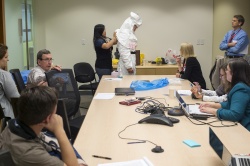Ebola
CDC Charges Johns Hopkins to Lead Development of Ebola Training Module
Johns Hopkins Medicine has been tasked by the Centers for Disease Control and Prevention to lead a group and to design an interactive Web-based learning program that guides health care workers, nurses and physicians through government-approved protocols to aid clinicians as they provide care to patients who may be at risk of contracting the Ebola virus.

The program trains health care providers in three critical areas: proper donning of personal protective equipment (PPE), the safe removal of gear and active monitoring skills. All three modules will be available for free on the CDC’s website in the coming weeks and later available to the millions of iOS users on iTunes U.
Spearheading the initiative are infection prevention and safety experts from the Johns Hopkins Armstrong Institute for Patient Safety and Quality. Over the course of five days, the team worked with experts in infectious disease, nursing, systems engineering, content development and visual design from across the country to create an interactive learning experience for health care workers. The 40-member, multidisciplinary team included representatives from academic institutions, such as Miami University (Oxford, Ohio) to professional organizations, such as the Association for Professionals in Infection Control and Epidemiology.
“This is a unique time in health care where collaboration between public, private, and government entities is essential to help solve this new crisis,” says Peter Pronovost, M.D., Ph.D., senior vice president for patient safety and quality improvement at Johns Hopkins Medicine, and director of the Armstrong Institute. “This innovative environment has prompted spirited discussions from different areas of expertise, and these types of respectful conversations result in a better resource for nurses and physicians—and an overall better health outcome for dedicated care providers across our nation.”
To prepare for the online program’s development, systems engineers visited The Johns Hopkins Hospital to watch a team of biocontainment experts to understand the specific environment and constraints faced by nurses and clinicians caring for patients who could possibly have contracted Ebola virus disease. Next, the full team reviewed the CDC guidelines and searched for possible discrepancies between the words written on the page, and the actions performed by care providers in the hospital.
“People in general are so scared with Ebola, and they don’t understand how hard it can be to take on and off this protective equipment,” said Sandy Swoboda, R.N., M.S., an intensive care nurse at Johns Hopkins Hospital and a simulation educator and clinical researcher with the Johns Hopkins schools of medicine and nursing. “To an untrained eye, it looks easy, but there are specific procedures and steps that you have to follow. A misstep can lead to a potentially negative health outcome.”
Elements such as limited space in a hospital room or even the anxiety and exhaustion of the health care workers can further complicate intensive situations. Using a variety of human factors and safety engineering methods, the team is identifying potential safety failures in the donning and doffing of protective gear and risk factors that could lead to contamination. Module scripts highlight these risks and how to mitigate them to make it easier for clinicians to comply with CDC guidelines in a real situation. These instructions are then tested in a simulation center, where novices and experts replicate the guidelines described. Revised and corrected steps are then filmed.
“People are visual learners,” says Ayse Gurses, Ph.D., a human factors engineer and patient safety faculty member with the Armstrong Institute, and project leader for the group behind the modules’ development. “To be efficient and effective, information must be presented contextually as well as visually to engage health care workers and help them retain the information for use in real-world situations when working with patients.”
The course will be available through iTunes U, the world’s largest online catalog of free educational content from top schools and prominent organizations. According to Forbes, more than 85 percent of physicians in the United States have iOS devices, providing instant access to this much-needed iTunes U content right on their Apple devices.
27.10.2014








